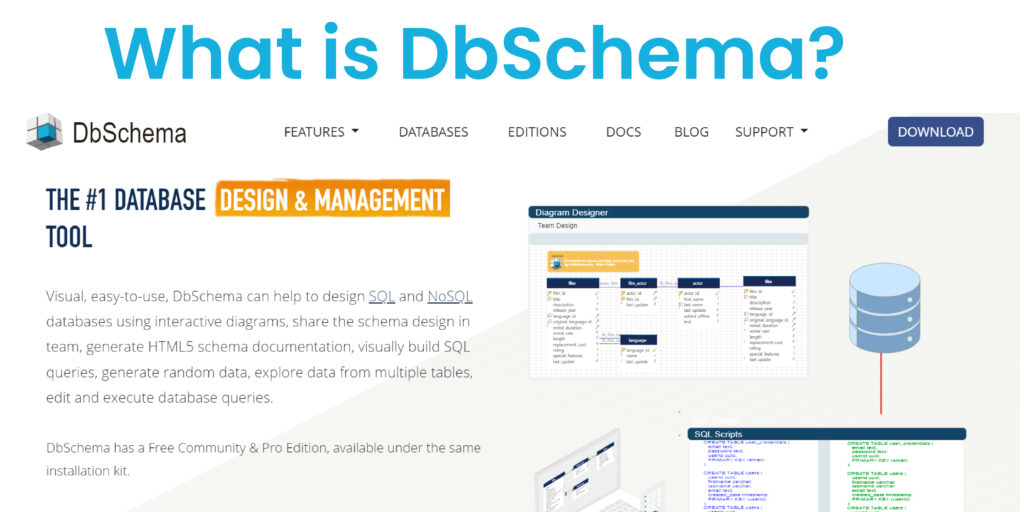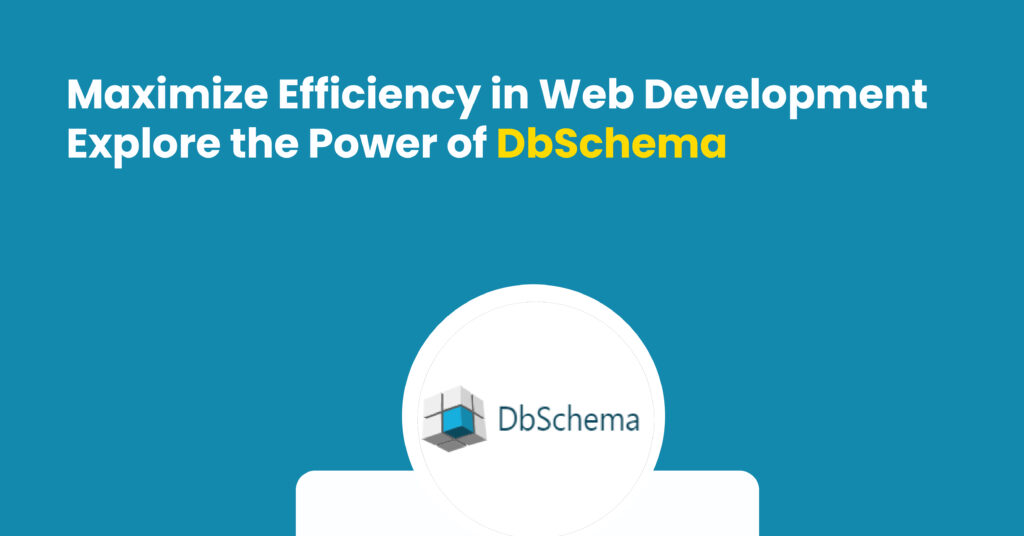Increasing efficiency and streamlining processes are ever-evolving priorities in the web development space. The standout solution is DbSchema, which is designed to revolutionize database management, visualization, and interaction. It demonstrates how DbSchema can be a game-changer in web development by exploring its multifaceted capabilities.
In addition to being a tool, DbSchema is a comprehensive ecosystem for designing, documenting, and understanding complex databases. Both beginners and professionals will find it easily usable, making it a versatile choice for many projects. DbSchema offers a comprehensive platform for database-related tasks, from creating interactive diagrams to executing complex SQL queries.
Developers can visualize and manage databases without getting bogged down in technical details with DbSchema’s ability to simplify complex data structures. In addition to saving time and enhancing accuracy, this visual database design and management approach reduces errors.
In the following sections, we will explore how it stands out in its field, its unique features, and how it can transform web development workflows. Today’s fast-paced digital world makes DbSchema an invaluable developer asset by increasing productivity and improving web application quality.
Table of Contents
ToggleWhat is DbSchema?

Web developers, database administrators, and data analysts can use DbSchema to manage databases efficiently and visualize schemas. In the tech world, this comprehensive tool stands out for its user-friendly approach to complex database design and interaction, making it an indispensable asset for database management and web development.
Through graphical diagrams, users can build, visualize, and manage database schemas using DbSchema, an interactive database designer and management system. Visual representation makes it easier for experienced and new database managers to understand complex data structures.
Creating and managing interactive layouts is one of DbSchema’s key strengths. These layouts simplify the design process by giving a better understanding of relationships and structures. With a straightforward graphical interface, users can easily create new tables, define relationships, and edit existing structures, enhancing efficiency and accuracy.
Many database systems are compatible with DbSchema, including popular options such as MySQL, PostgreSQL, SQL Server, and Oracle. Users can switch between different databases seamlessly with DbSchema’s flexibility, making it an ideal choice for various projects and environments.
The Role of DbSchema in Web Development
As a comprehensive database tool, DbSchema plays a crucial role in the intricate world of web development. The software allows developers to design, visualize, and interact with database schemas, thus enhancing productivity and efficiency.
Streamlined database design
Web developers can easily construct and understand complex database structures with DbSchema’s interactive diagrams. By graphically designing tables, relationships, and other database elements, DbSchema speeds up web application development and reduces errors.
Enhanced Data Understanding
Developing effective applications requires understanding the underlying data structure. With DbSchema, you can visualize data relationships and data flows intuitively. By understanding the database better, you can better write more efficient queries and align application logic with it.
Improved collaboration
Developers can share and discuss database designs in DbSchema, ensuring consistency and understanding throughout the team. This collaborative environment is essential, with multiple developers working on the same database.
Simplified Query Building
By making database interactions more accessible and reducing query-writing time, DbSchema’s Visual Query Builder is a boon for developers who may not be SQL experts.
Database Documentation and Reporting
Web development requires proper documentation. By documenting database schemas and generating reports, DbSchema ensures that developers clearly understand the database structure, which is crucial to ongoing maintenance and development.
Improving Efficiency with DbSchema
By streamlining database-related tasks, DbSchema enhances efficiency in web development. In addition to simplifying database design and management, it also accelerates development cycles, boosting productivity.
- Accelerated Database Design: In DbSchema’s visual design tools, developers can quickly build and modify database schemas, eliminating the tedium associated with manual scripting. In addition to allowing quick alterations and updates, interactive diagrams enable agile responses to changing project requirements. Project kick-offs and development cycles are faster when the design phase is efficient.
- Simplified Data Exploration and Management: By providing a spreadsheet-like interface to interact with databases, DbSchema simplifies data exploration and manipulation. By eliminating the complexity of direct database queries, it reduces complexity. With its user-friendly interface, developers can view, edit, and manage data quickly, making testing and refining application functionality easier.
- Efficient query development: DbSchema’s Visual Query Builder is a time-saver for developers, especially those less experienced with SQL. By enabling the creation of complex queries through a drag-and-drop interface, it reduces the learning curve and minimizes query writing time. This tool allows developers to focus more on the logic and syntax of database queries.
- Enhanced Collaboration and Consistency: In team settings where multiple developers work on the same project, the tool’s collaborative features ensure consistency across different development environments. DbSchema minimizes conflicts and redundancies by keeping database schemas synchronized.
- Streamlined deployment and maintenance: It helps maintain database integrity across different stages of development and production with features like schema synchronization and deployment. This ensures a smoother transition from development to production environments, reducing deployment-related issues and downtim
DbSchema Unique Features
By offering a suite of unique features tailored to web developers and database administrators, DbSchema stands out in database tools. In addition to streamlining various database tasks, these features enhance database interaction and management efficiency.
- Visual Database Design and Interactive Diagrams: A key feature of DbSchema is visual database schema creation. Those with limited database experience can easily design, visualize, and understand complex database structures with interactive diagrams. Defining relationships, tables, and schemas is more complicated in traditional text-based tools. This graphical approach simplifies it.
- Layouts for Different Views:There are multiple layouts for the same schema in DbSchema. The forms can focus on specific aspects of the database, making large or complex schemas easier to manage. Users can view the same database differently, tailored to particular tasks or preferences.
- Relational Data Browse and Editor: DbSchema’s relational data editor makes data browsing and editing easier, unlike many traditional database tools. Direct data manipulation is simplified with this feature, enabling quick edits and intuitive data management.
- Visual Query Builder with Joins: With DbSchema’s Visual Query Builder, users can drag and drop complex SQL queries. With this tool, you can build intricate questions without deep SQL knowledge, which supports joins and other advanced SQL features.
- Schema Synchronization Across Different Databases: A feature not commonly found in other database tools is DbSchema’s ability to sync database schemas across different database types. A common challenge in web development is maintaining consistency in database structures across different environments.
- Robust Schema for Documentation and Reporting: It is particularly useful for large projects and teams to maintain proper documentation, essential to maintaining good data integrity.
- Reverse Engineering of Existing Databases: For legacy systems or when documentation is lacking, DbSchema’s reverse engineering feature is invaluable.
Case Studies: Success Stories with DbSchema
Numerous web development projects have relied on DbSchema to achieve success, demonstrating its versatility and effectiveness. Here are some case studies that show this.
E-Commerce Platform Optimization
With a complex database critical for their day-to-day operations, a leading e-commerce company faced challenges managing and visualizing it. Using DbSchema’s interactive diagrams and visual design features, they were able to redesign their database schema more efficiently. In addition to reducing query response times by 30%, the online platform performed significantly better, enhancing customer experience.
Health sector data management
Data from sensitive patients was managed by a research institute using DbSchema. By using the relational data browse and editor feature, they were able to handle data more securely and efficiently while using the visual query builder for research purposes. By streamlining data management, more accurate research outcomes were achieved.
Educational Institution Database Overhaul
By utilizing DbSchema’s reverse engineering capabilities, an educational institution could understand and restructure its outdated and inefficient database system quickly. As a result of schema synchronization, their development and production environments were consistent, resulting in a more reliable and stable data management system.
Tech Startup Agile Development
In agile development, a tech startup utilized DbSchema. As their development team collaborated more effectively, they clearly understood the database structure with the multiple layout options and schema documentation features of DbSchema. Consequently, their web application was developed faster and more efficiently.
From optimizing business operations to facilitating research and education, DbSchema can profoundly impact various settings. Any organization dealing with complex databases will benefit from its ability to streamline database management, enhance data visualization, and improve collaboration.
Comparative analysis
It’s important to compare DbSchema with other popular database tools before purchasing. The following analysis shows how DbSchema stands out from the competition.
Database Management Tools vs. DbSchema
- Visual Database Design: Its user-friendly and intuitive graphic design interface sets it apart from many traditional database design tools. Understanding and managing complex database schemas is easier with interactive diagrams and layouts.
- Multiple Database Compatibility: Database types supported by DbSchema include MySQL, PostgreSQL, SQL Server, and Oracle. Other tools often cater to specific database systems, limiting their applicability across different environments.
- Interactive data editor: DbSchema’s relational data browse and editor provides a spreadsheet-like interface for data management, providing straightforward data manipulation that is not present in many traditional tools.
DBSchema vs Modern Database Tools
- Visual Query Builder: The Visual Query Builder in DbSchema offers a more comprehensive and user-friendly approach than many competing tools. It supports complex queries and joins and is particularly useful for complex queries.
- Schema Synchronization and Reverse Engineering: This feature makes DbSchema particularly useful for managing large projects and working with legacy systems, where some modern tools fall short.
- Documentation and reporting: Documentation and reporting are crucial to database management, and DbSchema provides robust functionality. With its extensive feature set, DbSchema is indispensable for large and complex projects.
Workflow integration with DbSchema
The visual tools in DbSchema allow you to create an interactive diagram of your current database schema and quickly understand your database structure and relationships. Using these tools to create a database schema is great for starting a new project.
- Efficient data management:With a spreadsheet-like interface, this relational data editor streamlines data manipulation and makes it easier to view, edit, and manage your database data.
- Query building and optimization: Build and optimize SQL queries using the Visual Query Builder. This tool is particularly helpful for those who do not need to become more familiar with SQL.
- Collaboration and consistency: In tea, Usea’s collaborative features allow you to share database designs in a team environment and ensure consistency across your team. The schema synchronization feature is useful for maintaining uniformity across different development environments.
- Ongoing maintenance and documentation: Document your database structure regularly for long-term care and scalability with DbSchema’s documentation and reporting capabilities.
- Adapting and expanding: Adapting and developing your database schema is easy with DbSchema. Its reverse engineering capabilities also make integration and migration easy.
DbSchema Future in Web Development
In the future, web development will be more data-driven, and tools like DbSchema are leading the way. The role of efficient database management tools becomes increasingly critical as web applications become more complex and database-driven. Web development’s future is well-positioned with DbSchema’s advanced features and user-friendly interface.
- Embracing Cloud and Big Data Trends: Cloud computing and big data dominate the tech landscape, so DbSchema is an ideal tool for the future. Modern web applications that heavily rely on cloud-based and big data technologies can benefit from their ability to manage extensive data sets and integrate with various database types.
- Enhanced Collaboration in Remote Work Environments: Collaboration and efficiency are essential to remote work. Distributed teams benefit from DbSchema’s collaborative features, like schema sharing and synchronization, ensuring consistency and facilitating developers’ communication.
- Integration with Emerging Technologies: DbSchema’s integration with emerging technologies like AI, machine learning, and IoT could enable automated database optimization and predictive analytics, leading to smarter management systems for complex web applications.
- Commitment to Continuous Improvement: DbSchema developers are committed to continuous improvement and adapting to web development trends. With its adaptability, DbSchema will continue to evolve, incorporating cutting-edge features as web development demands change.
- Driving User-Friendly Database Management: Using DbSchema, even those with limited database technical expertise can easily design and manage their databases. As web development becomes more democratized, tools such as DbSchema that lower the entry barrier will become increasingly important.
Pros and Cons
- User Interface: Easily navigable and understandable visual interface.
- Database Design: The interactive diagram simplifies database design.
- Compatibility: Multi-database support.
- Query building: Create complex SQL queries easily with Visual Query Builder.
- Pricing: Flexible pricing plans for individuals and teams.
- User Interface: New users may find it overwhelming
- Database Design: For full use, some database knowledge is required.
- Compatibility :Different databases may have different advanced features.
- Query Building: A hand-coded query may be more flexible.
- Pricing :Freelancers or small projects may find cost a barrier.
DbSchema Pricing & Plans
Individual users, teams, and enterprises will find DbSchema’s updated pricing plans in April 2023. Depending on features, number of users, and support levels, subscription-based models and perpetual licenses may be available. It is important to visit the official DbSchema website or contact their sales team for the most accurate and current pricing information.
Perpetual License Save
2 months-
Databases (all)
-
Maintenance + Upgrades First Year Free
Reviews DbSchema
DbSchema stands out as an exceptional tool for database design and management, particularly appealing for its user-friendly visual interface. Its capability to generate interactive diagrams simplifies the understanding of complex database structures, making it accessible to both novices and experienced users. The Visual Query Builder is a highlight, offering an intuitive way to create complex SQL queries. Additionally, its compatibility with various database systems adds to its versatility. While there is a learning curve, the comprehensive features justify the investment in time. Overall, DbSchema is a robust, efficient solution for database management, suitable for a wide range of web development project.
Conclusion
Web developers and marketers find Systeme.io an invaluable asset in an online ecosystem that values efficiency and integration. This platform simplifies web development and boosts online business growth by offering many marketing and sales tools. By democratizing web development, Systeme.io makes it accessible to a broader audience without compromising functionality. Systeme io offers a powerful yet easy-to-use solution for businesses looking to streamline their online operations and grow their business.

My name is Robert James, and I have over a decade of experience in digital marketing and technology innovation. I have contributed to numerous successful campaigns and advancements in artificial intelligence marketing. With a focus on AI, I hold a Master’s degree in Computer Science. I am sought after by tech forums and publications. I explore and demystify the evolving landscape of AI in marketing by sharing my knowledge.


